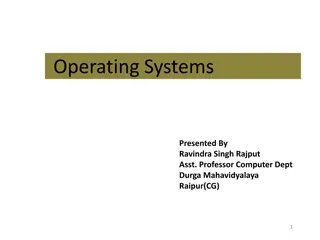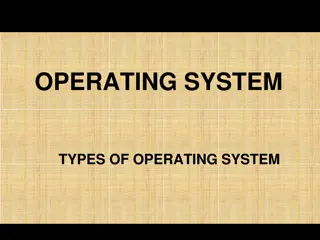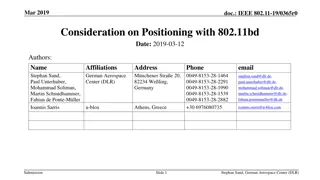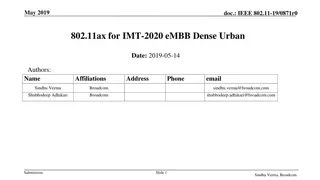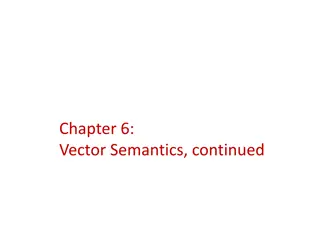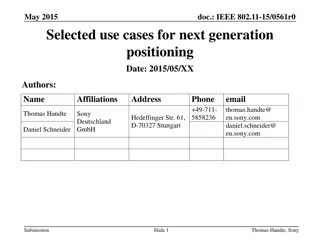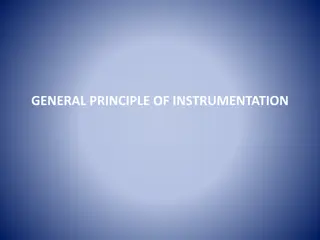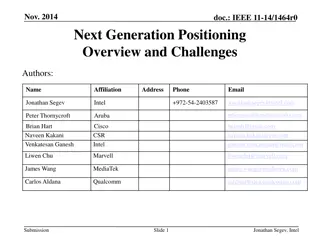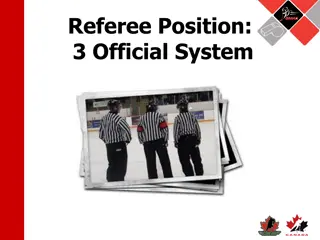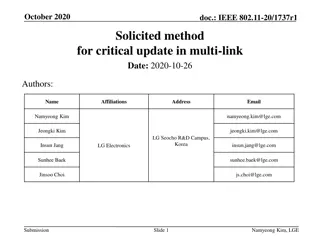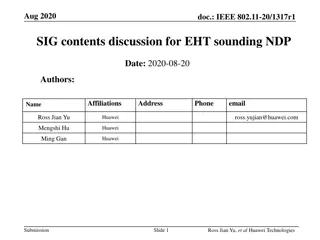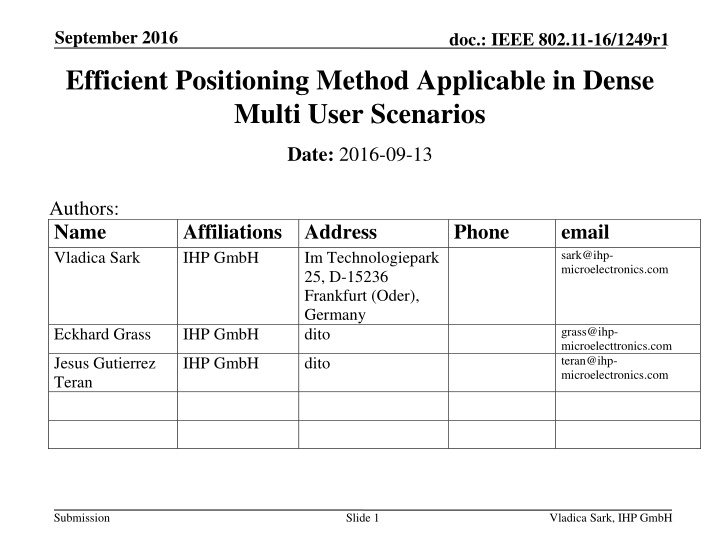
Efficient Positioning Method for Dense Multi-User Scenarios
"Discover a novel method for positioning in dense multi-user scenarios to minimize transmissions. Explore extensions for infrastructure-centric localization like secure geo-fencing. Overcome limitations in localization with the proposed hyperbolic navigation and sequential transmission solutions."
Download Presentation

Please find below an Image/Link to download the presentation.
The content on the website is provided AS IS for your information and personal use only. It may not be sold, licensed, or shared on other websites without obtaining consent from the author. If you encounter any issues during the download, it is possible that the publisher has removed the file from their server.
You are allowed to download the files provided on this website for personal or commercial use, subject to the condition that they are used lawfully. All files are the property of their respective owners.
The content on the website is provided AS IS for your information and personal use only. It may not be sold, licensed, or shared on other websites without obtaining consent from the author.
E N D
Presentation Transcript
September 2016 doc.: IEEE 802.11-16/1249r1 Efficient Positioning Method Applicable in Dense Multi User Scenarios Date: 2016-09-13 Authors: Name Vladica Sark Affiliations Address IHP GmbH Phone email sark@ihp- microelectronics.com Im Technologiepark 25, D-15236 Frankfurt (Oder), Germany dito grass@ihp- microelecttronics.com teran@ihp- microelectronics.com Eckhard Grass IHP GmbH Jesus Gutierrez Teran IHP GmbH dito Submission Slide 1 Vladica Sark, IHP GmbH
September 2016 doc.: IEEE 802.11-16/1249r1 Abstract Firstly, we propose a new method for positioning, which can be used in dense multiuser scenarios. The main objective is to reduce the number of transmissions needed. Secondly, the proposed method is extended in order to be used for infrastructure-centric localization and applications, such as secure geo-fencing etc. Submission Slide 2 Vladica Sark, IHP GmbH
September 2016 doc.: IEEE 802.11-16/1249r1 Localization in Dense Multi User Scenarios The Fine Timing Measurement (FTM) protocol generates additional traffic overhead and is hardly applicable in scenarios with a large number of users According to [1], 384 s is the minimum time per single FTM exchange With 1000 users and 0.5 Hz update rate (one update per 2 seconds) the medium is consumed for 19% of the time. [1] With N co-channel APs, the overhead gets N-fold worse [1] Averaging is usually used for improving the measurement precision. This additionally increases the overhead Submission Slide 3 Vladica Sark, IHP GmbH
September 2016 doc.: IEEE 802.11-16/1249r1 Hyperbolic Navigation The hyperbolic navigation approach described in [2] is partially solving this issue AP1 and AP2 perform a RTT measurement between them AP1 sends a frame to AP2 and AP2 back to AP1 The frames need to have similar (and relatively long) lengths in order to achieve precise time of arrival estimation The number of transmissions by the access points is 6 for a 2D case and 8 for a 3D case, in the most general case, without any additional constraints Submission Slide 4 Vladica Sark, IHP GmbH
September 2016 doc.: IEEE 802.11-16/1249r1 Proposed solution (1) The proposed solution has similarities with GPS Except: Sequential transmission with virtual synchronization of APs AP1 transmits a timing frame (TF) frame to AP2, AP2 to AP3 and so on Replies from AP2 to AP1, AP3 to AP2 and so on, can be very short ACKs STAs also receive the TFs form the APs AP1 AP2 AP3 AP4 TF TF ACK TF ACK TF ACK STA Submission Slide 5 Vladica Sark, IHP GmbH
September 2016 doc.: IEEE 802.11-16/1249r1 Proposed solution (2) In order to obtain the position, the STAs passively listen to the transmitted frames The ToAs of TFs in STAs can be used to calculate the position The ToAs describe the radius of the distances from the STA to the APs Location estimation from the measured radiuses is a nonlinear problem which can be easily linearized Adding additional APs, in order to improve the localization position, leads to solving an overdetermined system of equations In the TFs, the forwarding times as well as the APs positions can be also included Main advantages over the hyperbolic approach is the reduced number of transmissions or shorter overall transmission time 2D case: 6 transmissions (hyperbolic) vs 4 transmissions (proposed) 3D case: 8 transmissions (hyperbolic) vs 5 transmissions (proposed) Submission Slide 6 Vladica Sark, IHP GmbH
September 2016 doc.: IEEE 802.11-16/1249r1 Passive positioning ? ??= ??+ ?????+ ???? ? 1 ?+ ??? ?=2 ?????=1 2+ ?? ?? 2+ ?? ?? 2 ?? ?? ? ? ???= ???? ? 1 ?+ ??? ?=2 ??= ??+1 2+ ?? ?? 2+ ?? ?? 2+ ??? ?? ?? ? ?? - time of the first transmission from AP1 ?? - time of arrival of the TF from APn to STA ????? - time of flight between APn and STA ???? ? 1 ? - time of flight between AP(i-1) and APi ??? - forwarding time of APn (??; ??; ??) - position of APn (??; ??; ??) - position of STA ? speed of light Submission Slide 7 Vladica Sark, IHP GmbH
September 2016 doc.: IEEE 802.11-16/1249r1 Extension to the proposed solution (1) This extension mainly affects use cases where infrastructure centric localization such as geo-fencing is required Internet access in coffee shop possible only inside Wireless network access in a company different rights, depending on location. No access outside from the premises of the company. Main idea is to extend the solution so that the APs can be used to actively locate the STAs, independently of the position estimated by the STA itself. Tampering with the position would be almost impossible. This is difficult to achieve with the methods where the STAs are only receiving the signals. They can report any position to the infrastructure. Submission Slide 8 Vladica Sark, IHP GmbH
September 2016 doc.: IEEE 802.11-16/1249r1 Extension to the proposed solution (2) After the APs transmit the TFs in round robin fashion, the stations transmit their TFs also in round robin fashion Trigger frames can be used to schedule the STAs transmissions Estimation of the location can be performed in 2 ways ToA, using the ToA of the TF transmitted by the STAs and received by the APs Two Way Ranging (TWR) as shown (AP1 to STA1 and STA1 back to AP1; AP2 to STA1 and STA1 back to AP2; etc.) AP1 AP2 AP3 AP4 STA1 STA2 Submission Slide 9 Vladica Sark, IHP GmbH
September 2016 doc.: IEEE 802.11-16/1249r1 Infrastructure positioning ???= ???+ ????? ?????=1 2+ ?? ?? 2+ ?? ?? 2 ?? ?? ? ???= ???+1 2+ ?? ?? 2+ ?? ?? 2 ?? ?? ? ??? - time of arrival of TF from STA to APn ??? - time of transmission of TF from STA ????? - time of flight from STA to APn (??; ??; ??) - position of APn (??; ??; ??) - position of STA ? speed of light Submission Slide 10 Vladica Sark, IHP GmbH
September 2016 doc.: IEEE 802.11-16/1249r1 Extension to the proposed solution (3) The APs can locate the user in use cases where this is required The first and the second approach can coexist, i.e. users that do not want to disclose their own position do not need to do so Additional position estimation performed by the APs, can be combined with the position estimated by the STAs, in order to improve the precision Submission Slide 11 Vladica Sark, IHP GmbH
September 2016 doc.: IEEE 802.11-16/1249r1 Conclusion The proposed approach further reduces the number of transmissions needed to perform localization of mobile stations It can be extended such that the APs (i.e. the infrastructure) can also locate STAs STAs that do not need this functionality can still perform localization on their own The number of APs can be increased in order to improve the localization precision; Channel usage increases linearly with the number of APs Submission Slide 12 Vladica Sark, IHP GmbH
September 2016 doc.: IEEE 802.11-16/1249r1 References [1] Brian Hart et al., Scalable Location, IEEE 802.11-14/1235r0 [2] Erik Lindskog, Client Positioning Using Timing Measurements between Access Points, IEEE 802.11-13/0072r0 Submission Slide 13 Vladica Sark, IHP GmbH
September 2016 doc.: IEEE 802.11-16/1249r1 Straw Poll 1.) Should the 802.11az protocol support at least one mode of operation that enables STAs to obtain their location by passively receiving measurement frames from fixed APs? Yes: No: Need more info: Abstain: 2.) Should wireless connectivity between access points be supported to allow sequential transmission of timing frames, and hence, facilitating virtual synchronization of APs? Yes: No: Need more info: Abstain: Submission Slide 14 Vladica Sark, IHP GmbH


